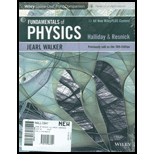
FUND.OF PHYSICS(LL)-PRINT COMP-W/ACCESS
11th Edition
ISBN: 9781119459170
Author: Halliday
Publisher: WILEY
expand_more
expand_more
format_list_bulleted
Concept explainers
Question
Chapter 40, Problem 9Q
To determine
To calculate:
(a) the number of components of the Kα line in a molybdenum target.
(b) the number components of the Kβ line in a molybdenum target.
Expert Solution & Answer
Want to see the full answer?
Check out a sample textbook solution
Students have asked these similar questions
Hi! I need help with these calculations for part i and part k for a physics Diffraction Lab. We used a slit width 0.4 mm to measure our pattern.
Examine the data and % error values in Data Table 3 where the angular displacement of the simple pendulum decreased but the mass of the pendulum bob and the length of the pendulum remained constant. Describe whether or not your data shows that the period of the pendulum depends on the angular displacement of the pendulum bob, to within a reasonable percent error.
In addition to the anyalysis of the graph, show mathematically that the slope of that line is 2π/√g . Using the slope of your line calculate the value of g and compare it to 9.8.
Chapter 40 Solutions
FUND.OF PHYSICS(LL)-PRINT COMP-W/ACCESS
Ch. 40 - Prob. 1QCh. 40 - Prob. 2QCh. 40 - Prob. 3QCh. 40 - Prob. 4QCh. 40 - Prob. 5QCh. 40 - Prob. 6QCh. 40 - Prob. 7QCh. 40 - Figure 40-22 shows three points at which a spin-up...Ch. 40 - Prob. 9QCh. 40 - Prob. 10Q
Ch. 40 - Prob. 11QCh. 40 - Prob. 12QCh. 40 - Prob. 13QCh. 40 - Prob. 14QCh. 40 - Prob. 1PCh. 40 - Prob. 2PCh. 40 - Prob. 3PCh. 40 - Prob. 4PCh. 40 - Prob. 5PCh. 40 - Prob. 6PCh. 40 - Prob. 7PCh. 40 - Prob. 8PCh. 40 - Prob. 9PCh. 40 - Prob. 10PCh. 40 - Prob. 11PCh. 40 - Prob. 12PCh. 40 - SSM What is the acceleration of a silver atom as...Ch. 40 - Prob. 14PCh. 40 - Prob. 15PCh. 40 - Assume that in the SternGerlach experiment as...Ch. 40 - Prob. 17PCh. 40 - Prob. 18PCh. 40 - Prob. 19PCh. 40 - Prob. 20PCh. 40 - Prob. 21PCh. 40 - Prob. 22PCh. 40 - Prob. 23PCh. 40 - Prob. 24PCh. 40 - Prob. 25PCh. 40 - Prob. 26PCh. 40 - Prob. 27PCh. 40 - Show that the number of states with the same...Ch. 40 - Prob. 29PCh. 40 - For a helium atom in its ground state, what are...Ch. 40 - Prob. 31PCh. 40 - Prob. 32PCh. 40 - Prob. 33PCh. 40 - Prob. 34PCh. 40 - Prob. 35PCh. 40 - Prob. 36PCh. 40 - Prob. 37PCh. 40 - Prob. 38PCh. 40 - Prob. 39PCh. 40 - Prob. 40PCh. 40 - Prob. 41PCh. 40 - Prob. 42PCh. 40 - Prob. 43PCh. 40 - Prob. 44PCh. 40 - Prob. 45PCh. 40 - Prob. 46PCh. 40 - Prob. 47PCh. 40 - Prob. 48PCh. 40 - Prob. 49PCh. 40 - Prob. 50PCh. 40 - Prob. 51PCh. 40 - Prob. 52PCh. 40 - Prob. 53PCh. 40 - Prob. 54PCh. 40 - Prob. 55PCh. 40 - Prob. 56PCh. 40 - Prob. 57PCh. 40 - Prob. 58PCh. 40 - Prob. 59PCh. 40 - Prob. 60PCh. 40 - Prob. 61PCh. 40 - Prob. 62PCh. 40 - Prob. 63PCh. 40 - Prob. 64PCh. 40 - Prob. 65PCh. 40 - Prob. 66PCh. 40 - Prob. 67PCh. 40 - Prob. 68PCh. 40 - Prob. 69PCh. 40 - Prob. 70PCh. 40 - Prob. 71PCh. 40 - Prob. 72PCh. 40 - Prob. 73PCh. 40 - Prob. 74PCh. 40 - Prob. 75PCh. 40 - Prob. 76PCh. 40 - Prob. 77PCh. 40 - Prob. 78PCh. 40 - Prob. 79P
Knowledge Booster
Learn more about
Need a deep-dive on the concept behind this application? Look no further. Learn more about this topic, physics and related others by exploring similar questions and additional content below.Similar questions
- An object is placed 24.1 cm to the left of a diverging lens (f = -6.51 cm). A concave mirror (f= 14.8 cm) is placed 30.2 cm to the right of the lens to form an image of the first image formed by the lens. Find the final image distance, measured relative to the mirror. (b) Is the final image real or virtual? (c) Is the final image upright or inverted with respect to the original object?arrow_forwardConcept Simulation 26.4 provides the option of exploring the ray diagram that applies to this problem. The distance between an object and its image formed by a diverging lens is 5.90 cm. The focal length of the lens is -2.60 cm. Find (a) the image distance and (b) the object distance.arrow_forwardPls help ASAParrow_forward
arrow_back_ios
SEE MORE QUESTIONS
arrow_forward_ios
Recommended textbooks for you
 College PhysicsPhysicsISBN:9781285737027Author:Raymond A. Serway, Chris VuillePublisher:Cengage Learning
College PhysicsPhysicsISBN:9781285737027Author:Raymond A. Serway, Chris VuillePublisher:Cengage Learning Modern PhysicsPhysicsISBN:9781111794378Author:Raymond A. Serway, Clement J. Moses, Curt A. MoyerPublisher:Cengage Learning
Modern PhysicsPhysicsISBN:9781111794378Author:Raymond A. Serway, Clement J. Moses, Curt A. MoyerPublisher:Cengage Learning University Physics Volume 3PhysicsISBN:9781938168185Author:William Moebs, Jeff SannyPublisher:OpenStax
University Physics Volume 3PhysicsISBN:9781938168185Author:William Moebs, Jeff SannyPublisher:OpenStax Principles of Physics: A Calculus-Based TextPhysicsISBN:9781133104261Author:Raymond A. Serway, John W. JewettPublisher:Cengage Learning
Principles of Physics: A Calculus-Based TextPhysicsISBN:9781133104261Author:Raymond A. Serway, John W. JewettPublisher:Cengage Learning Physics for Scientists and Engineers with Modern ...PhysicsISBN:9781337553292Author:Raymond A. Serway, John W. JewettPublisher:Cengage Learning
Physics for Scientists and Engineers with Modern ...PhysicsISBN:9781337553292Author:Raymond A. Serway, John W. JewettPublisher:Cengage Learning

College Physics
Physics
ISBN:9781285737027
Author:Raymond A. Serway, Chris Vuille
Publisher:Cengage Learning

Modern Physics
Physics
ISBN:9781111794378
Author:Raymond A. Serway, Clement J. Moses, Curt A. Moyer
Publisher:Cengage Learning

University Physics Volume 3
Physics
ISBN:9781938168185
Author:William Moebs, Jeff Sanny
Publisher:OpenStax

Principles of Physics: A Calculus-Based Text
Physics
ISBN:9781133104261
Author:Raymond A. Serway, John W. Jewett
Publisher:Cengage Learning


Physics for Scientists and Engineers with Modern ...
Physics
ISBN:9781337553292
Author:Raymond A. Serway, John W. Jewett
Publisher:Cengage Learning